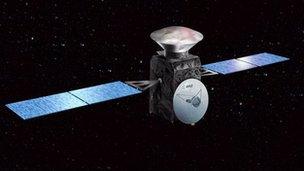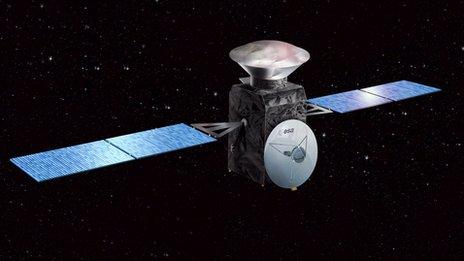Russia and Europe joint Mars bid agreement approved
- Published

The ExoMars project has suffered a number of delays and setbacks
Europe and Russia are cementing their plans to explore Mars together.
European Space Agency member states have approved the agreement that would see Russia take significant roles in Red Planet missions in 2016 and 2018.
The former is a satellite that will look for methane and other trace gases in the atmosphere; the latter will be a surface rover.
Russian participation fills a void left by the Americans who pulled back from the projects earlier this year.
For a while, it looked as though the ventures, known as ExoMars, might have to be cancelled. But Russian desire to pick up many of the elements dropped by the US means ExoMars is now on a much surer footing.
Esa member states indicated their happiness with the cooperation text on Monday. All that remains is for the documentation to be signed by both parties.
This is likely to happen before the end of the year.
'Other opportunities'
Officials say they want the ExoMars partnership to be the catalyst for further planetary exploration ventures.
"We have other opportunities to consider cooperation - for Jupiter missions, for example," said Frederic Nordlund, the head of international relations at Esa.
"Esa has selected Juice, a large mission for Jupiter, and in Russia there is a plan for a Ganymede lander which is of interest to Europe.

The ExoMars plan includes an orbiter as well as a surface rover
"We are initiating discussions to see how we could co-operate on those missions. But this could extend to lunar robotics where we would like to see if we could join forces as well.
"Russia already has its Luna-Glob and Luna-Resurs missions, which are already being implemented, but we're considering other opportunities for this in other areas."
The planned agreement calls for Russia to provide the Proton rockets to send the two ExoMars missions on their way.
Russia would also get instrument space on the 2016 satellite and the 2018 rover. In addition, its researchers would join the science teams that exploit the missions' data.
One key contribution would be the landing system that places the rover on the surface of the Red Planet. With the exception of some key components, this would be built by Russian industry.
ExoMars was formally initiated in Europe by ministers in 2005, and Esa has so far spent in excess of 400m euros on technology development.
The final budget on the European side is projected to be about 1.2bn euros for the two missions.
So far, 850m of that total has been committed. But officials remain confident of closing the gap.
The 2016 orbiter will try to track down the sources of methane that have been observed at Mars. Its presence in the atmosphere is intriguing and could conceivably indicate biological activity on the planet. A key role for the satellite also will be to provide the communications relay for the 2018 rover.
The six-wheeled vehicle would look for signs of past or present life. It would have the ability to drill 2m into the ground.
Jonathan.Amos-INTERNET@bbc.co.uk and follow me on Twitter: @BBCAmos, external
- Published6 February 2012

- Published14 October 2011

- Published14 February 2012
- Published13 February 2012
